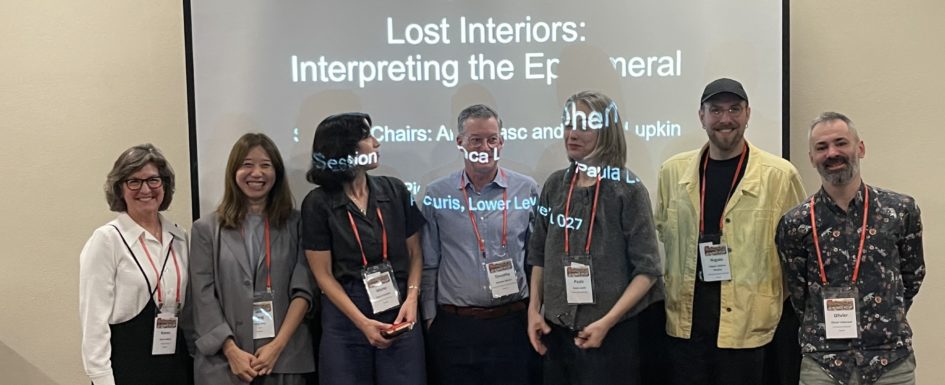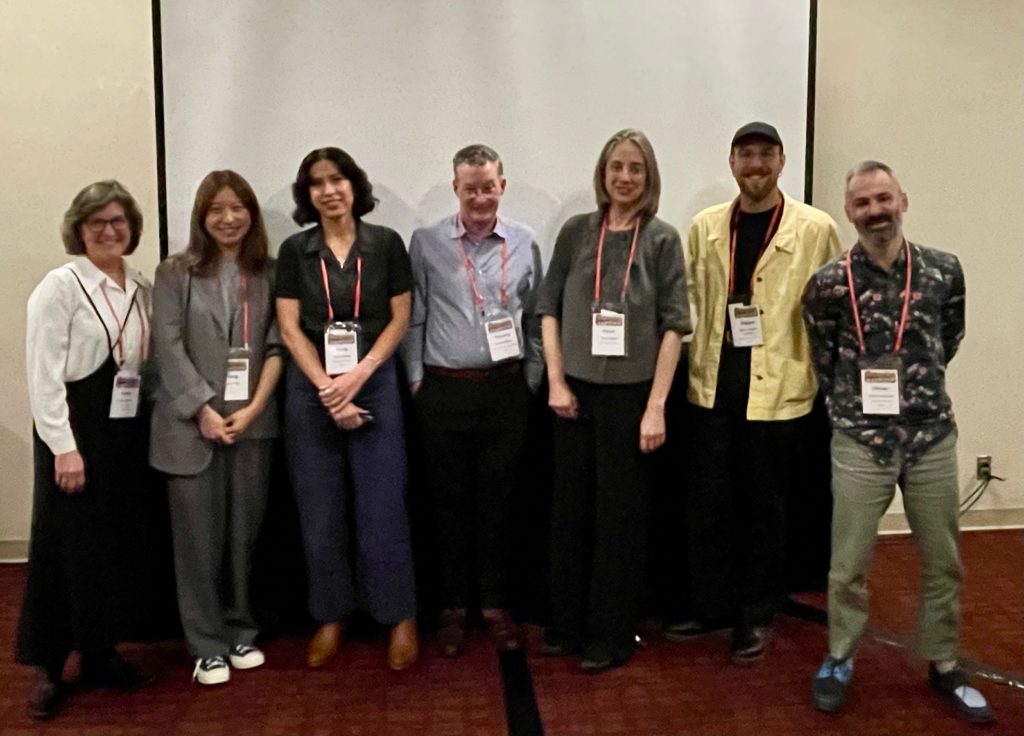
Lost Interiors: Interpreting the Ephemeral
Society of Architectural Historians Annual Meeting, Albuquerque (NM), 2024
Thursday April 18 from 11am to 1pm
Chairs: Anca Lasc and Paula Lupkin
- Interiority and Mestizaje: Entanglements in the Tejano Borderlands. Marie Saldaña, University of Tennessee, Knoxville, USA
- Ephemeral but Entangled Interiors in Corporate Modernism: Knoll International Canada. Karen R. White, Humber College, Canada
- Ephemerality, the Photograph, the Projected Image, and the Archive: Researching late 1960s “Instant Interiors.” Timothy Rohan, University of Massachusetts Amherst, USA
- Queer Mappings: Imagining Lost Interiors. Hugues Lefebvre Morasse, Université de Montréal, Canada, and Olivier Vallerand, Université de Montréal, Canada
- Disposable Interiors: The Trend of Rental Housing Makeovers in China. Yang Yang, University of California, Los Angeles, USA
Lost Interiors: Interpreting the Ephemeral opened with just a few brief words from Paula Lupkin as chair. After introducing HIG and its program of events to attendees, Lupkin acknowledged the role of Anca Lasc, the organization’s co-president, in shaping the session and selecting the excellent slate of presenters.
Drawing on the CFP, Lupkin introduced the session, which addressed the lifecycle and experience of ephemeral interiors through new methods, theories, archival sources, and innovative technologies. The session participants explored intersections with vernacular architecture, installation art, queer space, politics and design, and the use of crowdsourcing and social media to understand everyday space.
Marie Saldana focused on the impact of mesitzaje, or blending, in our understanding and analysis of Tejano “interiority” of the 19th century borderlands of the United States and Mexico. This spatial concept was not determined by physical walls, but rather followed the shape and patterns of communal life and environmental exigencies, resting lightly on the land. To recover the ephemeral, lost, overwritten building traditions of the Tejano Southwest, she relied upon written accounts from two well-known writer-travelers, Frederick Law Olmsted and Abbé Emmanuel Domenech, as well as fieldwork photographs, prints and paintings of the period. Her work seeks to enrich narratives of historic architecture, interiors, and landscape with the addition of Tejano design traditions. The inclusion of these “lost” interiors adds complexity to current day narratives about culture, borders, and immigration.
Karen White’s presentation worked to recover the political and professional meaning of a lost Canadian interior: the new Toronto City Hall (1965). Known as the “great furniture fiasco” the design for desks, chairs, and tables was ultimately awarded by competition to the Canadian subsidiary of Knoll International. A competition was held for the furnishing of its public spaces which resulted in a “great furniture fiasco.” Within the local and national design and political communities, issues of cost, modern design, and national identity very publicly took center stage. Her analysis of this project’s meaning concluded with photographs of these furniture pieces today, orphaned from their original design and placement and stripped of their original meaning. This presentation explored the political dimension of ephemeral interiors, demonstrating the role of research-based “reconstruction” in the recovery of meaning.
Tim Rohan’s presentation introduced a 1970s interior design concept, “instant interiors.” Using the new Kodak Carousel projectors, artist Romuald Witwicki transformed Manhattan apartment interiors with temporary and transparent patterns and color which shifted regularly. The use of technology and the lack of materiality added a new time-based dimension to the design and experience of interiors, stretching the definition of the term in a new direction. Complementing the ephemerality of the light experiences was the use of moveable modular platforms and seating, adding a seemingly endless set of ever-changing permutations to this interior phenomenon. Such strategies linked interiors to the rise of installation art in the same time period. Particularly hard to document, these never permanent, “instantaneous” interiors were recorded through photograph and interviews in professional magazines, art journals, and the New York Times.
Olivier Vallerand and Hugues Lefebvre Morasse presented next, offering a creative approach to the study of queer interiors: spaces that are intentionally opaque, private, and ephemeral. Rarely documented in photographs or standard representations of design like the plan or section, the bathhouse is nearly impossible to recover using empirical means. Instead, they turned to digital models and film sets to portray imagined queer utopian or even mythological interiors. Drawing upon queer and architectural theory, including Rem Koolhaas’ “vertical urbanism,” they introduce the concept of “interiorized urbanism” to characterize a private, imagined interior world, sheltered from surveillance and danger. Such imagined interiors link embodied experience and conceptual representation of “pure” interiors, free from any reality or literal connection to the streets or public space. Their joint presentation offered a strategy for processing memory and experience of gendered space, challenging and stretching the boundaries and definition of historic interiors.
Yang Yang continued to stretch the boundaries of the field beyond the empirical, using Chinese social media apps like Little Red Book to explore the temporary, disposable interior design of rental apartments as an expression of young people’s identity. The transitory “soft furnishings” of the apartments are posted and shared with the public according to algorithms that sort photographs according to taste and budget, providing a macro-level view of consumer behavior and DIY, personalizing standard, mass-market spaces. Her paper tracked her development of an exciting new method that combines the statistical, visual, communal and everyday life and experience of domestic spaces today.
Questions from the audience at the end of the session included a message of appreciation from Mari Nakahara, Curator of Architecture, Design, and Technology at the Library of Congress. She asked how archivists and librarians could support the study of ephemeral interiors. The directions and approaches of the session’s presenters suggested the importance of oral history, fieldwork, contemporary written accounts, photography, and film in addition to the drawings of furniture and interior designers. Overall, the session offered HIG and the SAH compelling insights into the particular scholarly questions raised by new technologies, sources and approaches to interior space, broadly conceived.

